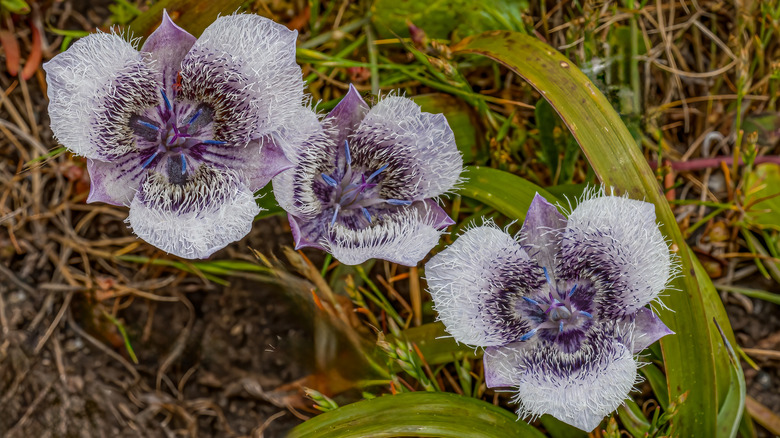The Star-Shaped Wildflower That Will Fill Your Garden With A Sweet Scent
Are you on the hunt for tips on setting up a sensory-friendly garden? To be truly beneficial, such a planted space should pique all of our senses, from taste, touch, and hearing to seeing and smell. Like the incorporation of fruit, vegetables, and culinary herbs, scent is one of the easier parts of the sensory garden equation to get right. There's an abundance of plants with aromatic blooms to choose from. Why not, though, choose native wildflowers when you have the opportunity? One such blossoming bulb goes by the common name Tolmie's star tulip. It not only boasts a scent so appealing that its fragrant oil is extracted for use in the cosmetic industry, but it also has soft and furry flower petals that help you tick off the touch box on your sensory garden checklist.
The botanical name for Tolimie's star tulip, which also goes by other common names including (though not limited to) Tolmie's cat's ear, Tolmie's mariposa lily, hairy star tulip, and pussy ears, is Calochortus tolmiei. The range of the genus extends through western North America to Mexico and Guatemala, though most species make California their home. The bulbous perennial plant reaches lofty heights of about 1 foot tall. While today the flower is mostly appreciated for its unique beauty by wildflower field spotters and home gardeners with a passion for native plants, the bulb of the plant has long been a traditional food for local indigenous communities. When not in flower, Tolmie's star tulip is either a minimalist spray of tall, green-gray, sword-like leaves or lying dormant under the soil.
Tolmie's star tulip: The sweet-scented appeal explained
Among all the colorful wildflowers you can grow in your garden, Tolmie's star tulip has some distinct advantages, especially where native wildlife are concerned. The flowers, which are honestly better described as bells than stars, have hairy petals in white, pink, or purple, sometimes with an additional fringe. The scent humans find so attractive — caused by evaporating volatile chemicals in the petals — isn't actually created by the tulip for us. The flowers are both male and female and are pollinated by insects, which likely accounts for the fragrance. Tolmie's star tulip flowers appear April through June, depending on the area, and are visited specifically by native bees and butterflies like Fender's blue butterfly and Taylor's checkerspot. Nodding seed pods follow the flowers.
Scent isn't the only advantage this unique wildflower offers the home gardener. In the wild, Tolmie's star tulip prefers dry, stony slopes or conifer and oak forest clearings. Outside of the obvious use of including it in your pollinator garden plans, the plant is a perfect fit for native meadows, rockeries, and forest margins. Scatter Tolmie's star tulip through your garden bed or pathway borders or plant the bulbs on tree-shaded slopes with other shade-loving understory greenery like ferns. Bulblets will develop from the main bulbs in a few years, at which time your single plant may start to form a patch. And, as tempting as it may be, refrain from picking the flowers for your spring vases. The plant will quickly go dormant if you do — though it will be dormant by summer no matter your actions.
Finding and growing Tolmie's star tulip
If you garden in Hardiness Zones 3 through 9, you can most likely grow Tolmie's star tulips. Seeds can be bought from nurseries that specialize in North American native plants; use the Native Seed Network to find suppliers. Note that seeds take two years to grow into bulbs after sprouting, so gardeners must be patient, or buy live plants. Live plants are available in 3 to 5 inch or medium band pots at specialist nurseries in the spring, but can also be found later in the year if you do some digging and get lucky. If you've acquired bulbs, pop them in the fridge and check them daily until you see roots growing.
It's best to sow Tolmei's star tulip seeds right when you collect them (what's referred to as ripe) or the following early spring. If you choose the latter method, employ a trick for winter seed sowing and stratify the seeds for up to 60 days. This briefly above-ground tulip has a wide variety of preferred habitats, which makes it notoriously challenging to grow in a garden setting. Plus, this pretty bulb is finicky about watering. The tulip wants little to no moisture when it goes dormant in the summer; conversely, it becomes decidedly more thirsty over the winter. Find a sunny spot for it (though it also tolerates part to full shade) in the ground or in a pot filled with an appropriate growing media — something similar to 4:3:1 of peat, sand, and red lava rock — and leave it well alone. Trim dead leaves occasionally.


